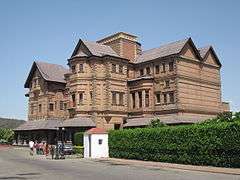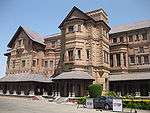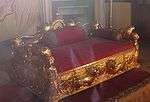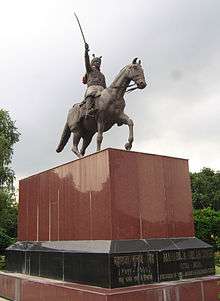Amar Mahal Palace
| Amar Mahal Palace | |
|---|---|
 Amar Mahal Palace Museum, | |
 Location within India | |
| General information | |
| Architectural style | Continental castle architecture |
| Town or city | Jammu |
| Country | India |
| Coordinates | 32°44′53″N 74°52′19″E / 32.748°N 74.872°E |
| Completed | 1890s |
| Client | Raja Amar Singh |
| Technical details | |
| Structural system | Red Sandstones and bricks |
| Design and construction | |
| Architect | French architect |
| Engineer | French engineer |
The Amar Mahal Palace is a palace in Jammu, in the Indian state of Jammu and Kashmir, India, which has now been converted into a Museum. It was built in the nineteenth century for Raja Amar Singh, a Dogra king by a French architect on the lines of a French Chateau. The palace was donated to the Hari-Tara charitable trust by Dr. Karan Singh for use as a museum.[1] It has many exhibits including a golden throne weighing 120 kg, Pahari miniature and Kangra miniature paintings, a library of 25,000 antique books and many rare art collections.[1][2][3]
The palace was the last official residence of the Dogra dynasty, and a large collection of portraits of the royal family are also on display in the Museum.[4]
Geography
Amar Mahal is situated on the right bank of the Tawi River, on a bend of the river, in Jammu. Jammu, once a princely city, is also famous for forts, palaces and temples. The Sivalik Hills or ranges to the north of the Mahal, on the left bank of the river, provide a grand view, with the Tawi River flowing in between, draining the valley. It is well located adjoining the heritage hotel known as the Hari Niwas Palace Hotel, in the heart of the city, on the road to Kashmir.[1][2]
History
The Amar Mahal Palace was planned by a French architect, in 1862. However, it was not built until the 1890s. Maharani Tara Devi, wife of the late Maharaja Hari Singh (son of Raja Amar Singh) lived in this palace till her death in 1967. Subsequently, her son Karan Singh and his wife Yasho Rajya Lakshmi converted the palace into a museum to house rare books and works of art, with the objective of “Encouraging artistic talent, to establish fine arts centre and to collaborate with other like minded institutions for promotion of Indian arts”. For this purpose, they transferred the palace property to a trust named as the “Hari-Tara Charitable Trust”. Karan Singh voluntarily surrendered the Privy Purse paid to him by the Government of India as a former ruler of Jammu, one of the Princely state of India, and used the funds to set up this museum named in memory of his parents.
The museum was inaugurated by the Indira Gandhi, Prime Minister of India, on April 13, 1975. To promote the stated objectives, the Trust arranges guided tours, book readings, lectures, film shows and hobby classes and other visitor friendly activities in the Museum. Scholarly exchanges, workshops and exhibitions are also regular features held by the Trust.[5][6] The Dogra-Pahari paintings displayed in the museum were creation of the second half of the 18th century in Jammu and Himachal Pradesh of the Kangra school of art. To quote the words of Karan Singh: “The whole effect is to transport one into a fascinating miniature world with its own aura and ethos.”[7]
Architecture


The palace built in red sandstone with red bricks is in a picturesque environment on a hillock overlooking the Tawi river valley. Built in the European castle style, the palace has sloping roofs with turrets and tall towers.[1] When built during the reign of Raja Amar Singh, it was the tallest building in Jammu.[8] The imposing building has long passages on three sides, which are covered by sloping corrugated tin roofs. The passages are supported on columns with wooden framework. The first floor of the palace building has French windows with connected balcony. The top floor has a bay window. The windows also depict triangular projections in classical Greek architectural style, which are fitted over ornate false columns.[9]
Displays
Only four rooms of the palace are open depicting Pahari paintings of Mahabharata epic scenes and royal memorabilia. A golden sofa of the Dogra rulers, weighing 120 kg in pure gold, embedded with golden lions at the corners, is housed in a hexagonal room in the museum, which is viewed only through glass covered window panes as the main door is kept locked for security reasons.[1][2] The art works of some of the renowned Indian artists like M.F. Hussain, J.Swaminathan, G. R. Santosh, Bikash Battacharjee, Ram Kumar, Laxman Pai are also on display in the museum.[9] In one of the galleries, paintings of Hindu epic stories such as of Nala Damayanti (a set of forty-seven miniature paintings) are depicted. Modern version of the Dashavatara paintings (ten avatars of Hindu god Vishnu) are also displayed in a separate ante-chamber in the Museum. These are unusual modern art set of paintings.[9] Family portraits of the Dogra rulers of Jammu and Kashmir are on display in the Durbar Hall at the entrance gallery. In the first and second floors, a few chambers house the library, which has a collection of rare antique books (25,000) on religion, philosophy and political science to fiction.[10]
An exclusive chamber in the museum, once the living quarters of the Maharani (later called the Maharajmata) Tara Devi, is conserved and exhibited in its original form where a silver bedspread, period furniture, photographs, the decoration of the Crown of India which was presented to her in 1945, her personal items of clothing and the unique Victorian bath room are on display.[10]

Gallery
 A plaque in the Amar Mahal Museum
A plaque in the Amar Mahal Museum Miniature Pahari paintings
Miniature Pahari paintings
References
- 1 2 3 4 5 "Amar Mahal Palace Museum". National Informatics Centre. Archived from the original on 23 March 2010. Retrieved 2010-04-01.
- 1 2 3 Bradnock, Robert; Roma Bradnock (2000). Indian Himalaya handbook: the travel guide. Footprint Travel Guides. ISBN 1-900949-79-2. Retrieved 2010-04-01.
- ↑ "Amar Mahal Palace Museum". Retrieved 2010-04-01.
- ↑ Bindloss, Joe; Sarina Singh (2007). India. Lonely Planet. p. 364. ISBN 1-74104-308-5. Retrieved 2010-04-04.
- ↑ "Amar Mahal Mseum and Library". Karansingh.com. Retrieved 2010-04-01.
- ↑ Gandhi, Kishor; Singh, Karan (Sadr-i-Riyasat of Jammu and Kashmir) (1991). The Transition to a global society. Allied Publishers. p. 251. ISBN 81-7023-320-8. Retrieved 2010-04-01.
- ↑ File:A plaque in the Amar Mahal Museum.jpg
- ↑ Desh, Bandhu (1989). Jammu Kashmir and Ladakh: tourist-attractions & tourism. Anmol Publications PVT. LTD. p. 82. ISBN 81-7158-014-9. Retrieved 2010-04-01.
- 1 2 3 "Jammu:Amar Mahal Palace". Archived from the original on 10 April 2010. Retrieved 2010-04-04.
- 1 2 "Amar Mahal Museum". Kashmir Tourism. Archived from the original on April 20, 2006. Retrieved 2010-04-04.